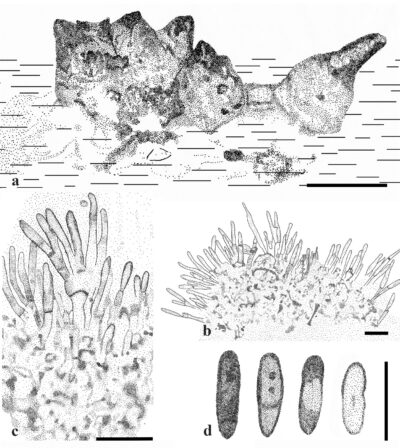Fungalpedia – Note 391, Xylochrysis
Xylochrysis Réblová
Citation when using this data: Tibpromma et al. 2024 (in prep.) – Fungalpedia, Ascomycota.
Index Fungorum, Facesoffungi, MycoBank, GenBank, Fig. 1
Classification: Incertae sedis, Incertae sedis, Sordariomycetidae, Sordariomycetes, Pezizomycotina, Ascomycota, Fungi.
Based on Phylogenetic analysis of two ribosomal (nc18S and nc28S rDNA) and one protein-coding (RPB2) genes, Réblová et al. (2014) identified Xylochrysis as a monotypic wood inhabiting the genus from Rhododendron. Xylochrysis is typified by Xylochrysis lucida. Xylochrysis consists of aggregated ascomata with an astromatic or stromatic base surrounded by a pigmented layer of cells (Réblová et al. 2014). Xylochrysis distinct among lignicolous Sordariomycetidae as it forms conspicuous, golden yellow perithecia with black, glabrous necks. Later, Zhang et al. (2017a) established Woswasiaceae to accommodate Xylochrysis together with Cyanoannulus and, Woswasia. Recently, Song et al. (2023) introduced Xylochrysis aquatica from aquatic environment. The concatenated ITS, LSU, SSU, tef1-α, and rpb2 multigene phylogenies from Song et al. (2023) stabilized Xylochrysis in Woswasiaceae.
Type species: Xylochrysis lucida Réblová, V. Štěpánek & R.K. Schumach
Other accepted species: Species Fungorum – search Xylochrysis
Figure 1 – Xylochrysis lucida (PRM 922621, CBS 135996). a Ascomata on decorticated wood or erumpent through the periderm. b, c Conidiophores with metulae and conidiogenous cells on PDA. d Conidia. Scale bars: a = 500 μm, b-d = 10 μm. Redrawn from Réblová et al. (2014).
References
Entry by
Karunarathna A, Department of Entomology and Plant Pathology, Faculty of Agriculture, Chiang Mai University, Chiang Mai 50200, Thailand.
(Edited by Saowaluck Tibpromma, Samaneh Chaharmiri-Dokhaharani, & Achala R. Rathnayaka)
Published online 26 November 2024
